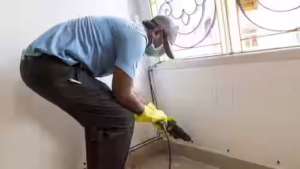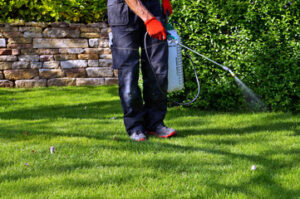Rodents carry disease-causing germs that can contaminate your products and threaten the health of employees and customers. They can also cause costly damage to equipment and tarnish your reputation.
Rodents seek food, shelter and nesting sites, which makes facilities like restaurants and shipping warehouses a prime target. Regular inspections for signs of rodent infestation, such as gnaw marks and greasy smears, help prevent them from entering your facility. Contact Commercial Rodent Control now!

Rodents like to nest and feed in warm places, where they can avoid predators and find easy access to food. They can also cause damage by chewing through wiring and structural components, as well as contaminating products with their urine and droppings. Rodents can even transmit diseases to humans and other animals through contact with contaminated surfaces.
There are many preventive measures that can be taken to stop a rodent problem before it starts. Regularly inspect your building and surrounding areas for signs of a pest infestation, such as gnaw marks or droppings. Pay attention to the behaviour of any pets you have – increased scratching and sniffing at certain locations may be their way of telling you that they smell rodents.
A commercial pest control company can help you prevent an infestation with their expertise and industry-specific treatment methods. In addition to eliminating existing pests, they can recommend sanitation practices and physical alterations to make your business less attractive to rodents. They can also provide ongoing inspections and monitoring, to ensure that you always have the best possible protection from these unwanted visitors.
Rodents can access wall and ceiling voids, crawl spaces and attics. Therefore, it is important to reduce the number of points of entry. This can be achieved by sealing any cracks or holes with caulk, especially those around utility lines and boxes. You should also install door sweeps and repair any damaged or torn window or door screens.
In addition, you can try installing door and window guards to further deter rodents. You can use high-density foam surrounded by stainless steel mesh to fill gaps, as well as weather stripping. You should also consider installing a termite barrier, which uses liquid chemicals to create a protective layer against these pests.
Regularly check your food storage and preparation areas for signs of rodents, such as gnaw marks or droppings. It is a good idea to perform regular walk-throughs of your kitchen to spot any potential problems early on, as they can quickly swell into an infestation and pose serious health risks. Rodents can carry dangerous bacteria such as E. coli, Salmonella and Listeria and contaminate food with their droppings and urine.
Detection
Rodents will exploit any opening they can get into, and rodent-proofing techniques must be utilized to prevent these pests from entering your business. The first step involves a thorough exterior inspection for any gaps, cracks or holes that must be sealed. Terminix technicians are trained to identify these potential entry points, based on their size, location and appearance. Then they will use the appropriate material to seal these spaces. In addition, they will look for signs of rodent activity such as rub marks, gnaw marks and droppings.
Once inside, rodents will immediately start causing damage. Their incisors continue to grow throughout their lives, so they must chew on materials like electrical wiring, insulation and woodwork to keep them at a manageable length. This can cause fire hazards, plumbing issues, costly repairs and structural integrity problems. It is also a health hazard, as rats and mice carry more than 35 diseases that can be passed on to humans through bites, scratches or handling, or from eating contaminated food items.
Aside from the monetary and health concerns, rodents can tarnish a company’s reputation, especially in the hospitality or food service industries. They can disrupt operations and even cause a loss of customers.
The simplest way to detect rodents is by looking for droppings. These small, dark stains can be found along walls, in pantry shelves and other places where food materials are stored. Another common sign is paw prints. Listening for scratching, squeaking and scurrying sounds is also an indication that rodents are present.
For commercial properties, a professional pest control expert is the best bet to detect and treat rodent infestations. They will create a tailored treatment plan for your specific space, using a combination of traps, baits, and exclusion methods to ensure complete rodent protection. Services include visual inspections, sanitation recommendations and recurring treatments to help you maintain a safe and healthy working environment. They will also work with you to make necessary changes to your premises to prevent future infestations. These measures will help you protect your brand and preserve a positive reputation in the community.
Exclusion
Rodents pose significant health and safety risks to human populations. They spread diseases like hantavirus and rat bite fever, contaminate food supplies, and cause extensive structural damage to buildings. Keeping rodents out of structures is the best way to protect people and property, which is why exclusion techniques are so important for commercial pest control.
The first step in exclusion is identifying the nooks and crannies that mice and rats use to enter structures. Thorough inspections of indoor and outdoor spaces help pest professionals pinpoint entry points, which can include gaps around windows and doors, cracks in foundations, and the small openings left by utility lines and vents. Once the locations of these openings are identified, pest exterminators can apply caulking and weather stripping to close them.
Another effective strategy is to make sure all buildings are fully enclosed, including the roof. Roof rats can squeeze through an opening as small as a quarter-inch, so it’s essential to ensure that all the vents and utility holes are sealed shut. Similarly, the openings under loading docks and entry doors need to be covered with solid rodent-proof sealants. Our Terminix technicians use products like the Flexi Armour seal, a caulking compound with stainless steel, to provide an effective and durable barrier against unwanted pests.
Maintaining a clean business is another crucial part of commercial rodent prevention. This means emptying trash bins regularly, cleaning out refrigerators, and keeping all workspaces free of clutter. Observing signs of rodent activity, such as droppings and urine trails, can also help businesses identify potential problem areas before they get out of hand.
While cleaning, vigilance, and structural maintenance are essential for commercial rodent control, these methods are not enough on their own to keep rodents out of business. For comprehensive pest protection, contact our professional team at Terminix Wil-Kil to discuss your needs and create a plan that works for you. We’ll work with you to develop a commercial pest control solution that keeps your property, reputation and employees safe from rodents for good. Call us today to get started.
Treatment
Rodent infestations pose serious health risks to the public and can damage a business’ reputation, especially in sectors like food service, retail, or hospitality. These pests are known carriers of diseases and contaminate products, workspaces, and materials with their droppings, urine, and feces. They also cause structural damage by gnawing on electrical wiring and plumbing, which may lead to costly repairs or fire hazards.
Rodent traps and poisons can be effective, but they often require frequent monitoring and can be dangerous to children and pets. Furthermore, rodents breed quickly. One mouse can produce up to four litters a year, each containing as many as six babies. As a result, a single mouse can quickly multiply into an infestation. Professional services offer targeted treatment techniques, a customized approach, sanitation recommendations, and recurring inspections to keep pests away in the long term.
Rodents can squeeze through gaps and holes as small as a quarter, making it crucial to inspect both the interior and exterior of commercial buildings for signs of entry. During these inspections, professionals look for rodent tracks, droppings, and signs of chewing on wiring or plumbing. They can then seal any openings using steel wool, caulk, or metal sheeting, paying special attention to areas around pipes and utility lines.
Aside from sealing entry points, regular cleaning and decluttering can help make a building less attractive to rodents. Remove trash regularly, store food in sealed containers, and keep basements and attics clean and dry. Natural repellents like peppermint oil and mothballs can be effective if used as part of a comprehensive strategy to keep rodents away.
Integrated rodent control is the best way to protect your home or business from mice and rats. In addition to sealing entry points, removing attractants, and implementing other prevention methods, our technicians use long-term solutions like rodent exclusion systems. These preventative measures keep rodents out and reduce the need for traps, poisons, or other short-term treatment methods. Contact us today for more information on how we can help you keep your property pest-free. We provide a wide range of residential and commercial pest management solutions.
